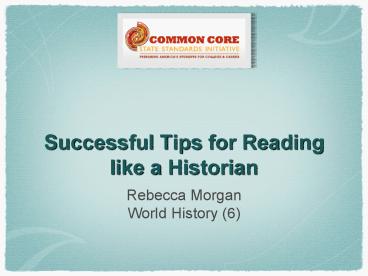Successful Tips for Reading like a Historian - PowerPoint PPT Presentation
1 / 10
Title:
Successful Tips for Reading like a Historian
Description:
Successful Tips for Reading like a Historian Rebecca Morgan World History (6) Goals Develop an awareness of reading strategies for best practices of literacy in ... – PowerPoint PPT presentation
Number of Views:169
Avg rating:3.0/5.0
Title: Successful Tips for Reading like a Historian
1
Successful Tips for Reading like a Historian
- Rebecca Morgan
- World History (6)
2
Goals
- Develop an awareness of reading strategies for
best practices of literacy in history and Social
Studies. - Increase understanding about the literacy
connections between Language Arts and Social
Studies
3
Social Studies is primarily the application of
language arts and critical thinking skills to
specific concepts and content
4
Historical Thinking Skills
- Sourcing (Who?, When?, Bias?)
- Contextualizing (Imaging, Historical or Cultural
Context) - Corroborating (Cross-Checking, Evidence
Triangulation) - Close Reading (Critical Reading, Tone, Language
Usage)
Reading Like a Historian Stanford History
Education Group
5
What is History?
- Accounts/narratives different depending on
perspective - We rely on evidence to construct account of the
past - We must question the reliability of evidence
- Any single piece of evidence is insufficient
- We must use multiple sources to build a plausible
account
Reading Like a Historian Stanford History
Education Group
6
Sourcing
- Who wrote this?
- What is the authors point of view?
- Why was it written?
- When was it written?
- Is the source believable?
Reading Like a Historian Stanford History
Education Group
7
Contextualizing
- What else was going on?
- What was it like to live in this time?
- What things were different?...the same?
- What would it look like to see this event through
the eyes of someone who lived back then?
Reading Like a Historian Stanford History
Education Group
8
Corroboration
- What do other pieces of evidence say?
- Am I finding the same information everywhere?
- Am I finding different versions? Why?
- Where else could I look to find out about this?
- What evidence is most believable?
9
Close Reading
- What claims does the author make?
- What evidence does the author use to support
those claims? - How is this document supposed to make me feel?
- What words of phrases does the author use to
convince me? - What information does the author leave out?
Reading Like a Historian Stanford History
Education Group
10
Comparing Sources
- Conduct a close reading of the two textbook
excerpts about the Boston Massacre - In what ways do the authors attempt to influence
the reader? - Which source would you consider more reliable?
Why? - Are textbooks reliable sources?
11
Be an Active Reader
- Predict what will happen next based on what has
already happened. - Question what is happening while you are reading.
- Summarize what you are reading frequently in
chunks. - Connect what is happening in the part youre
reading to what you have already read. - Clarify your understanding. Stop occasionally to
ask yourself whether you are confused by
anything. - Visualize what is happening in the text.































